Acrylic paint is a popular medium for artists due to its vibrant colors and versatility. However, many artists may not be aware of the importance of properly disposing of acrylic paint. Improper disposal can have negative effects on the environment and pose health hazards. In this article, we will explore the hazardous nature of acrylic paint, safe and eco-friendly methods for disposal, proper storage techniques, recycling options, local regulations, tips for reducing waste, alternative uses for leftover paint, and the environmental impact of improper disposal.
Why Proper Disposal of Acrylic Paint Is Important
Proper disposal of acrylic paint is crucial for several reasons. Firstly, acrylic paint contains chemicals that can be harmful to both humans and the environment. These chemicals can leach into the soil and water, causing pollution and potentially harming wildlife.
Secondly, improper disposal can lead to the clogging of drains and sewage systems, resulting in costly repairs. Lastly, responsible disposal practices help to protect our natural resources and ensure a sustainable future.
Understanding the Hazardous Nature of Acrylic Paint
Acrylic paint contains various chemicals, including pigments, binders, and solvents, which can be hazardous if not handled properly. Pigments often contain heavy metals such as cadmium, chromium, and lead, which can be toxic.
The binders and solvents in acrylic paint can also pose health risks if inhaled or ingested. When acrylic paint is disposed of incorrectly, these chemicals can contaminate the environment, leading to long-term damage.
Safe and Eco-Friendly Methods for Disposing of Acrylic Paint
There are several safe and eco-friendly methods for disposing of acrylic paint. One option is to dry out the paint completely before disposal. To do this, spread the paint thinly on a disposable surface or mix it with a drying agent.
Once the paint is completely dry, it can be disposed of in the regular trash. Another method is to donate unused paint to local schools, community centers, or art organizations. This allows others to benefit from the paint while reducing waste.
How to Store Acrylic Paint Properly to Minimize Waste
Proper storage of acrylic paint is essential to minimize waste. To extend the lifespan of your paint, make sure to tightly seal the containers after each use. Store the paint in a cool, dry place away from direct sunlight.
This will help prevent the paint from drying out or becoming contaminated. Additionally, label each container with the date of purchase or opening to keep track of its shelf life. By storing your acrylic paint properly, you can reduce waste and ensure its longevity.
Recycling Options for Acrylic Paint Containers
When it comes to recycling acrylic paint containers, it’s important to check with your local recycling facilities. Some recycling centers accept plastic paint containers, while others may not. If your local facilities do not accept paint containers, consider repurposing them for other storage needs. For example, you can use them to store small art supplies or organize your workspace. By finding alternative uses for the containers, you can reduce waste and give them a second life.
Local Regulations and Guidelines for Disposing of Acrylic Paint
It’s crucial to be aware of your local regulations and guidelines for disposing of acrylic paint. Different regions may have specific rules or recommendations for proper disposal. Some areas may provide designated drop-off locations or recycling programs for hazardous materials like acrylic paint.
Check with your local government or waste management agencies to ensure you are following the correct procedures. By adhering to these regulations, you can play your part in protecting the environment and promoting responsible waste management.
Tips for Reducing Waste and Using Acrylic Paint Efficiently
To reduce waste and use acrylic paint efficiently, consider the following tips:
- Plan your projects in advance to avoid purchasing more paint than necessary.
- Use a palette with multiple wells to keep colors separate and prevent mixing large quantities of paint.
- Clean your brushes and palettes properly to minimize leftover paint that goes to waste.
- Experiment with mixing colors to create new shades instead of buying additional tubes of paint.
- Store leftover paint in airtight containers to prevent drying or contamination.
By implementing these tips, you can make the most of your acrylic paint and minimize waste.
Alternative Uses for Leftover Acrylic Paint
Rather than disposing of leftover acrylic paint, consider exploring alternative uses. One option is to create abstract or mixed-media artworks by layering and combining different colors. You can also use leftover paint for small-scale projects such as painting on rocks, creating greeting cards, or decorating wooden crafts.
Additionally, you can mix acrylic paint with other materials like glue or fabric medium to create custom fabric designs. By finding creative ways to use leftover paint, you can reduce waste and unleash your artistic potential.
Environmental Impact of Improper Disposal of Acrylic Paint
Improper disposal of acrylic paint can have severe environmental consequences. When the paint is poured down the drain or thrown in the trash, the chemicals can contaminate water sources and harm aquatic life.
The heavy metals present in acrylic paint pigments can accumulate in the environment over time, leading to long-term damage. Additionally, the improper disposal of paint containers can contribute to plastic pollution. By being mindful of how we dispose of acrylic paint, we can minimize our impact on the environment and protect our natural resources.
Conclusion
Proper disposal of acrylic paint is essential for the environment and our well-being. By understanding the hazardous nature of acrylic paint, adopting safe and eco-friendly disposal methods, storing the paint properly, recycling containers, following local regulations, and reducing waste, we can minimize the negative impact of acrylic paint on our planet. Let’s be responsible artists and take the necessary steps to protect our environment for future generations.
